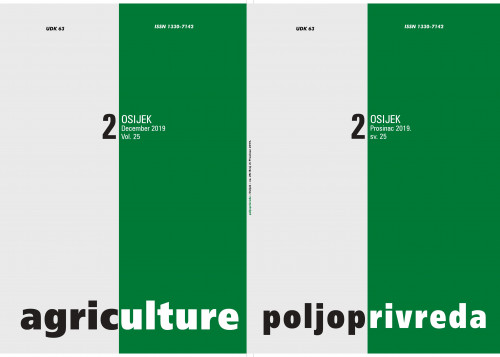Da bi se utvrdila mogućnost korištenja klorofilmetra u procjeni optimalne zrelosti listova flue-cured duhana za berbu, provedeni su dvogodišnji poljski pokusi. Postupci u pokusu bili su gnojidba dušikom (25 i 35 kg ha-1) i vrijeme berbe (rana, srednja i kasna berba). Relativni sadržaj klorofila 7., 11., 15. i 17. lista mjeren je u vrijeme berbe. Nakon berbe i sušenja tih listova analizirani su prinos i cijena te sadržaj nikotina i reducirajućih šećera. Nije bilo signifikantnog utjecaja gnojidbe dušikom na prosječni prinos, cijenu i sadržaj reducirajućih šećera. Međutim, dobivene su dvije interakcije gnojidba x vrijeme berbe za prinos. Viša gnojidba dušikom rezultirala je višim prosječnim sadržajem nikotina, ali samo u 15. i 17. listu u 2010. S obzirom na vrijeme berbe rezultati istraživanja su, uz nekoliko izuzetaka, pokazali da su viši prinosi, cijene, sadržaji nikotina i sadržaji reducirajućih šećera ostvareni srednjom ili/i kasnom berbom. Za pronalaženje raspona indeksa sadržaja klorofila u okviru kojeg bi se trebala provoditi berba listova duhana korišteni su matematički parametri odnosa između indeksa sadržaja klorofila u vrijeme berbe i istraživanih svojstava. U ovom istraživanju optimalno vrijeme za berbu listova duhana bilo je u rasponu indeksa sadržaja klorofila od 11-15.; In order to determine the possibility of using chlorophyll meter to estimate the optimal ripeness of flue-cured tobacco leaves for harvest, two-year field experiments were carried out. Treatments in the experiments were fertilization with nitrogen (25 and 35 kg ha-1) and harvesting time (early, middle and late harvest). The relative chlorophyll content of leaves 7, 11, 15 and 17 was measured at harvest time. After harvesting and drying these leaves, yield and price, as well as the content of nicotine and reducing sugars, were analysed. There was no significant influence of nitrogen fertilization on average yield, price and reducing sugars content. However, two interactions fertilization x harvesting time for yield were obtained. Higher nitrogen fertilization resulted in higher average nicotine content, but only in the 15th and 17th leaf in 2010. Given the time of harvest, the results of the research, with a few exceptions, showed that higher yields, prices, nicotine contents and reducing sugars contents were achieved in the middle and/or late harvest. To find the chlorophyll content index range within which the tobacco leaf harvests should be carried out, the mathematical parameters of the relationship between chlorophyll content index at harvest and investigated properties were used. In this study, the optimal time for tobacco leaf harvesting was in the chlorophyll content index range of 11 to 15 CCI.
Sažetak

 Poljoprivreda : 25,2(2019) / glavni i odgovorni urednik, editor-in-chief Manda Antunović.
Poljoprivreda : 25,2(2019) / glavni i odgovorni urednik, editor-in-chief Manda Antunović.